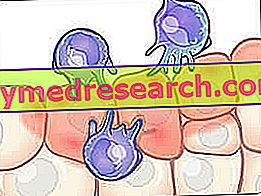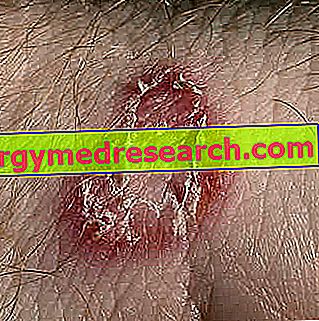Generality
The Moro reflex is a neonatal reflex that manifests itself as a jolt reaction, accompanied by the sudden opening of the arms and the lengthening of the legs.

This manifestation can be induced by various stimuli, such as a loud noise or the sudden and rapid movement of the child in a supine position. In response to the "fright", the newborn brings its head back, spreads its arms and extends its legs, then returns to close them in a gathered position, making a movement similar to an embrace . As a rule, the newborn loses Moro's reflex within the sixth month of life.
What's this
The Moro reflex is one of the primary neonatal ( or archaic ) reflexes and manifests itself with a jolt reaction, accompanied by the opening of the arms and the extension of the lower limbs. In practice, when he hears an unexpected sound or is left in a supine position, the child makes gestures as if trying to cling to something. Sometimes, after Moro's reflection, the crying follows.
Often, the mother causes this reaction involuntarily. In most cases, the Moro reflex is induced by moving the child in a supine position, on the changing table or in the cradle, abruptly or rapidly. Sometimes, it can be the crying of the same of the newborn to scare him.
The stimuli that can induce the Moro reflex are therefore not strictly specific and include exposure to:
- Sudden or loud noise;
- I blow on my face;
- Thermal stimuli (hot or cold) on the abdomen.
Phases of Moro's reflection
The reflection of Moro is articulated in two moments:
- First phase : coincides with the start or start of the newborn. In practice, we are witnessing the abrupt extension and abduction of the upper limbs with opening of the hands and hyperextension of the fingers for 1-2 seconds. In the first month of life, the extension of the spine can be added to the posture of the arms, with extension and abduction of the lower limbs.
- Second phase : a clinging reaction occurs, that is a slow flexion of the upper limbs on the trunk, with fist closing of the hands.
Why is it called that?
The reflection of Moro is named after Ernst Moro, the Austrian pediatrician who first described this phenomenon accurately in 1918. The reaction is also known as a reflection of Startle.
Causes
The Moro reflex belongs to a set of innate reactions and rhythmic automatisms of the limbs, which accompany each newborn in the first months of life .
This instinctive reaction occurs when the child:
- Does not perceive any point of secure support;
- He undergoes an abrupt change of position;
- He has the impression of not having a support under his back;
- He hears an unexpected sound.
The Moro reflex is a fundamental part of the development of the neonatal nervous system . The phenomenon is closely related to the functions of the labyrinth and it seems that the triggering stimuli start from the proprioceptors of the neck muscles. The resulting movements involve a massive commitment of the skeletal musculature: the Moro reflex produces an extensor posture in opposition to the flexor one typical of the newborn.
What do neonatal reflexes indicate?
Reflexes are involuntary movements. Some of these are spontaneous and are part of the normal activities of the newborn, others occur in response to certain stimuli. Neonatal reflexes are useful evaluation parameters for pediatricians, as they indicate the correct development of the nervous system, depending on their intensity and progressive disappearance with the passing of the months.
In addition to the Moro reflex, the primitive reactions normally present in the newborn are:
- Orientation reflex : it is caused by touching or touching the corner of the lips; the child turns his head and opens his mouth to approach the stimulus. This reflex helps the baby find the breast or bottle to start sucking.
- Grasp reflex : when touching the palm of the hand, the fingers close to form a fist, in order to take the thing that provoked the stimulus. This reflex lasts only a couple of months.
- Suction reflex : when the breast or bottle touches the palate, the baby begins to suck. Premature babies may have a weak or immature suckling reflex, since they are born before the complete development of this reflex. Newborns also have a hand-mouth reflex, so they can suck their hand or fingers.
- Babinski's reflex : by firmly touching the sole of the foot, the big toe moves towards the back of the foot and the other fingers widen. This reflex is normal up to 2 years.
- Reflex of the automatic gear : keeping the baby raised with his feet resting on a solid surface, the little one moves his legs as if to take steps.
How it manifests
The reflection of Moro manifests itself as a start: initially, the child bounces and extends his arms, spreading his hands and fingers (startle phase); the position remains fixed for 1-2 seconds, then the upper limbs are flexed and the fists close (clinging phase). At the start, generally, crying follows. After a few seconds, the reflection of Moro ends, the body relaxes and the arms return to rest on the chest.
This neonatal reaction is obtained in response to a loud noise or when the child is placed in the cradle or on the changing table abruptly. The Moro reflex lasts up to about 5-6 months of life.
When it appears
The Moro reflex manifests itself already in the womb: in the fetus, this phenomenon can occur already around the 28th gestational week, but reaches completeness around the 34th week.
When it disappears
Normally, the newborn loses Moro's reflex within the sixth month of life . Obviously, every child is different from the other and it can happen that this phenomenon, while decreasing in intensity, disappears later in time, but it still occurs in normal situations.
If the Moro reflex does not disappear within a year of age, it could be the alarm bell of a possible neurological problem, from which difficulties in language, balance, movement and coordination of the limbs may arise.
Among the causes that can lead to the persistence of the Moro reflex there are above all problems and conditions that occurred during pregnancy such as: stress, abortion threats, gestational diabetes or viral infections; other predisposing factors may occur during or immediately after birth.
Diagnosis
In the first days of life, the pediatrician evaluates the reflexes and motility of the newborn's limbs. As for the study of the Moro reflex, the maneuvers are varied.
During routine checks, Moro's reflex is usually induced by lifting the child, lying on his back, in a moment of quiet vigil; the doctor uses one hand to support the back and with the other holds the head, then lets the child's head fall back abruptly for a few centimeters.
Warning! The essential condition to adequately study the reflection of Moro is that the position of the head is symmetrical to the body axis. Furthermore, both hands of the newborn must be open, so as not to have an asymmetrical response. In fact, the palpable reflection reflex inhibits the Moro reflex.
The baby has the reflex to open his arms, as if he wanted to cling to something; then, the upper limbs return semi-flexed (as in an embrace) and the fist closes again.
Curiosity
Moro provoked the startle reflex by beating the pillow on which he rested the baby's head with one hand. The pediatrician thus determined a sudden movement of the child's head with respect to the trunk.
Clinical meaning
The Moro reflex is a completely physiological phenomenon: this basic movement reflects the normal development of the newborn (motor skills).
According to Ernst Moro, this reaction - similar to an embrace - manifests itself before the perception of a danger, a threat or the sudden detachment of the mother; the primary purpose of Moro's reflection would be precisely to keep the latter close. This could also explain why the palmar grasp inhibits the Moro reflex.
Furthermore, it must be emphasized that the mother, interpreting the reaction as a response to fear, tends to console the newborn, taking it in her arms. The contact and the exchange of words that follow contribute to further stimulate the child to modulate more elaborate motor and cognitive responses.
Moro reflex: when is it Normal?
The Moro reflex is present in all newborns, premature or full-term. The phenomenon is not found, however, in children with trisomy 21 (Down syndrome) or in those who have severe neurological defects or a disorder of the motor system .
The persistence of Moro's reflex over 6 months of life is commonly detected in the presence of cerebral palsy .
What does it mean if the child does not have this reflection?
The absence of the Moro reflex is abnormal, and may suggest, if bilateral, the presence of a central nervous system problem (ie damage to the brain or spinal cord). During neonatal examinations, the pediatrician will check whether the child is suffering from a form of hemiplegia or paralysis .
The unilateral absence of the Moro reflex suggests the possibility of a fracture of the clavicle or injury to the nerves that branch from the neck to the shoulder. Loss of muscle function on one side of the body can also produce an asymmetrical Moro reflex.
If it doesn't disappear, what does it mean?
The Moro reflex is present in all healthy newborns, both full-term and premature. This appears, in fact, in the embryonic period, between the 28th and 34th week of gestation.
The Moro reflex tends to disappear after 4-5 months from birth, however the process of losing this reaction is quite variable and sometimes persists longer.
In any case, it is important that there is a decrease in the Moro reflex and that this disappears within the first year of life; in the event that the child continues to manifest it, it is advisable to consult the pediatrician to investigate in depth the persistence of this reaction.
Note
The persistence of Moro's reflex over 6 months of life is significantly associated with attention deficit hyperactivity disorder (ADHD) in children aged 8-11 years.
Some advice
For parents who see it for the first time, Moro's reflection may seem dramatic, as the child stiffens and bursts into tears. This reaction is completely normal and is part of the normal development process.
When the child experiences the Moro reflex, it is advisable to try to calm him, letting him relax little by little.



